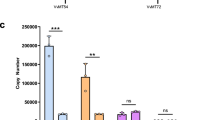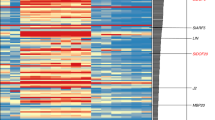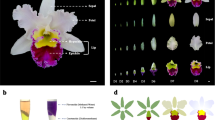Abstract
FLOWERS contain the reproductive cells of angiosperms. Floral meristems develop apically or subapically from vegetative axes, and the flower itself is often regarded as homologous with a compressed and determinate shoot1. Although in many extant angiosperms the fertile floral organs (stamens and carpels) resemble leaves in both development and morphology2, the struc-tures that give rise to the germ cells inside them (the anther and ovule) have no counterpart in any vegetative organ. The reproduc-tive cells of angiosperms therefore develop after a period of exclusively vegetative growth and, in contrast to those of animals, have no direct antecedents in the embryo3. So far, the molecular mechanisms that set the reproductive cells apart from those of the other components of the flower or from the vegetative organs are unknown. Here we describe an early and specific developmental switch in stamen and carpel primordia of pea (Pisum sativum L.) which alters expression of a plasma membrane arabinogalactan protein4 epitope in the progenitors of the germ cells, and which subsequently affects the gametes, zygote and globular-stage embryo.
This is a preview of subscription content, access via your institution
Access options
Subscribe to this journal
Receive 51 print issues and online access
$199.00 per year
only $3.90 per issue
Buy this article
- Purchase on Springer Link
- Instant access to full article PDF
Prices may be subject to local taxes which are calculated during checkout
Similar content being viewed by others
References
Arber, A. Biol. Rev. 12, 157–184 (1937).
Esau, K. in Anatomy of Seed Plants 2nd edn, 375–401 (Wiley, New York, 1977).
Walbot, V. Trends Genet 1, 165–169 (1985).
Fincher, G. B., Stone, B. A. & Clarke, A. E. A Rev. Pl. Physiol. 34, 47–70 (1983).
Pennell, R. I., Knox, J. P., Scofield, G. N., Selvendran, R. R. & Roberts, K. J. Cell Biol. 108, 1967–1977 (1989).
Feizi, T. & Childs, R. A. Biochem. J. 245, 1–11 (1987).
Roberts, K. Curr. Op. Cell Biol. 1, 1020–1027 (1989).
Bell, P. R. Adv. Bot. Res. 16, 55–87 (1989).
Drews, G. N. & Goldberg, R. B. Trends Genet. 5, 256–261 (1989).
Russell, S. D. Proc. natn. Acad. Sci. U.S.A. 82, 6129–6132 (1985).
Author information
Authors and Affiliations
Rights and permissions
About this article
Cite this article
Pennell, R., Roberts, K. Sexual development in the pea is presaged by altered expression of arabinogalactan protein. Nature 344, 547–549 (1990). https://doi.org/10.1038/344547a0
Received:
Accepted:
Issue Date:
DOI: https://doi.org/10.1038/344547a0
This article is cited by
-
Transcriptome profiling of differentially expressed genes in cytoplasmic male-sterile line and its fertility restorer line in pigeon pea (Cajanus cajan L.)
BMC Plant Biology (2020)
-
Arabinogalactan proteins and their sugar chains: functions in plant reproduction, research methods, and biosynthesis
Plant Reproduction (2018)
-
Arabinogalactan proteins: rising attention from plant biologists
Plant Reproduction (2015)
-
Galactosyltransferases from Arabidopsis thaliana in the biosynthesis of type II arabinogalactan: molecular interaction enhances enzyme activity
BMC Plant Biology (2014)
-
Quantification of arabinogalactan proteins during in vitro morphogenesis induced by β-d-glucosyl Yariv reagent in Centaurium erythraea root culture
Acta Physiologiae Plantarum (2014)
Comments
By submitting a comment you agree to abide by our Terms and Community Guidelines. If you find something abusive or that does not comply with our terms or guidelines please flag it as inappropriate.



